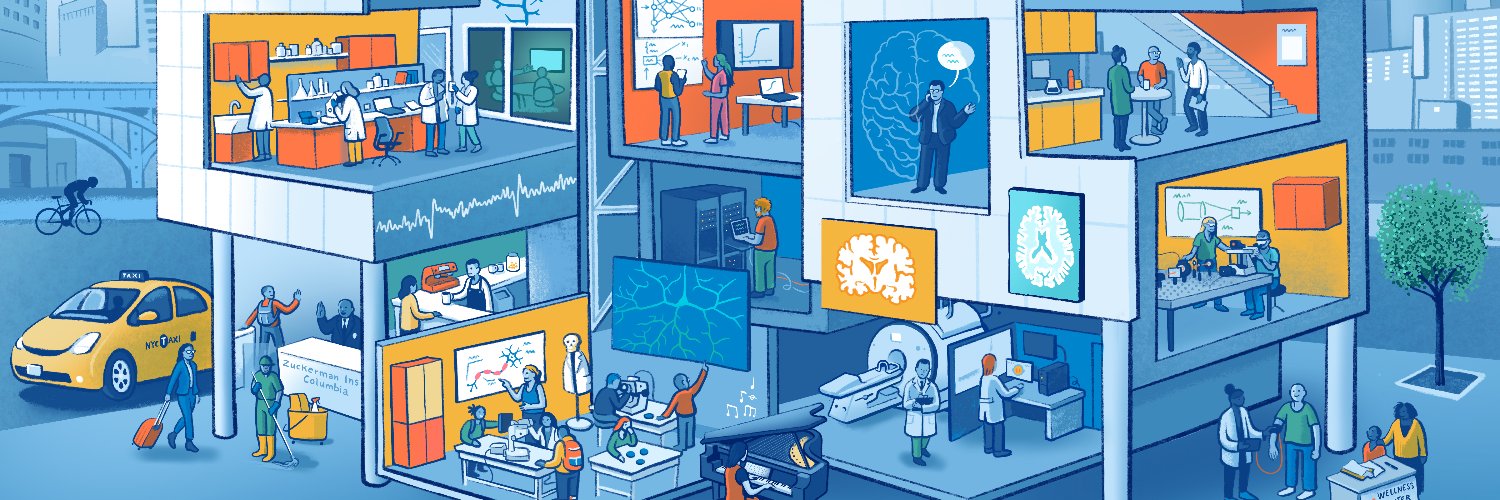
Columbia University's Zuckerman Institute
@ZuckermanBrain
Created by @Columbia to be the world's foremost neuroscience institute, we are deciphering the brain — how it develops, works, endures and recovers.
In a @statnews opinion piece, our CEO and Director @DShohamy reflects on recent funding cuts for scientists-in-training. She asks, “What am I supposed to say to this generation of young scientists?” Read more: statnews.com/2025/05/07/us-…

Victoria Abraira @VAbraira reflects on a paper from Charles Zuker’s lab that made her wonder which aspects of somatosensory circuits are hardwired, which are plastic and how we can change them, in our latest “This paper changed my life.” thetransmitter.org/this-paper-cha…
Framing human brains in terms borrowed from artificial intelligence is dangerous—writes @Dshohamy lab grad student @IddoGefen in @latimes. He explores the harm of trying to “optimize” or “fine-tune” people—for education, health, law, art or science. tinyurl.com/2zjsv892

What was @ZuckermanBrain up to in 2024? See for yourself in our Yearly Recap: bit.ly/ZIyearlyrecap

Congrats to @Columbia scientist @LintonVision who received the David Marr Medal from the Applied Vision Association for "pioneering research on visual experience." 🏆👁️🧠
Absolute honor to be awarded the David Marr Medal by the Applied Vision Association Looking forward to my talk “Five Illusions Challenge Our Understanding of Visual Experience” Thanks so much to NOMIS Foundation, @ItalianAcademy, @columbiacss, @KriegeskorteLab, @ZuckermanBrain
Recent funding cuts have targeted the training of new scientists across the United States. What does this mean for the future of discovery and innovation? Reflect with us here on the dangers of losing today’s young scientists: youtu.be/AZCAs4N7alU?fe…
Happy Pride Month! 🌈🧠 Black In Neuro celebrates the brilliance of our queer, trans & nonbinary members — and LGBTQIA+ people worldwide. 🌎 Black and queer excellence is at the heart of our community. ✨
How do you make a decision in a situation you’ve never encountered? Your brain may use your memories to do much of the thinking long before you have to make the choice. Read more by @DShohamy @jon_d_nicholas @nathanieldaw in @NatureComms zuckermaninstitute.columbia.edu/memories-can-s… #memory…

Come explore the workings of the brain at Saturday Science on June 7, and help us celebrate #ManhattanvilleCommunityDay with an amazing lineup of food, fun, and activities for all! More info: eventbrite.com/e/saturday-sci…

How do knots of DNA help create our sense of smell? Learn more from new research by @JoanPulupa, Natalie McArthur and @LomvardasLab in @Nature. Read: zuckermaninstitute.columbia.edu/how-knots-dna-… @columbia #neuroscience
This colorful brain image comes from a mouse with missing DNA. Its cells should be deformed and malfunctional. But @GogosLabZMBBI scientists used DNA fragments (yellow and green) to reverse the damage. Could this help people with genetic disease? Read zuckermaninstitute.columbia.edu/restoring-brai……

We are pleased to congratulate @YukiHaba_ of @Columbia on joining the 2025 cohort of #LeonLevyScholars in partnership with the Leon Levy Foundation. 👏 Learn more about Yuki & meet each of the Scholars in our latest press release. Read more: bit.nyas.org/3Yoa6Pf
Why create an AI model of a fish? New research from our own Nate Sawtell & Larry Abbott, along w/ @DenisTurcu @AllenInstitute, shows how real fish can use electricity to scan the world, findings that could help us understand our own senses, such as vision. @Columbia…

What’s at stake when scientific research funds are cut? Our own Erica Rodriguez talks about the grant canceled for her work on social behaviors (with autism and schizophrenia ties) and the impact on her career. @Gothamist tinyurl.com/yc34c64b

Science is revealing DNA’s many shapes and their roles in health & disease, from the growth of a fetus to the decay of Alzheimer’s. Now Joan Pulupa, Natalie McArthur & @LomvardasLab discover how DNA forms loops fastened with molecular zip ties. @Nature nature.com/articles/s4158…

For the first time, scientists Charles Zuker, @FitzpatrickLab and team have mapped the tongue’s sweet sensor. This could lead to new ways to curb our insatiable attraction to sugar. @Columbia @CellCellPress zuckermaninstitute.columbia.edu/scientists-map… #sweet #Neuroscience 🍬🧠
Over 20 years ago, Zuker et al. discovered the mammalian sweet taste receptors Now, an exciting collaboration between our labs @ColumbiaBiochem reveals the #cryoEM structure of the human sweet receptor-key to sweet taste perception-online @CellCellPress! sciencedirect.com/science/articl…
Join us tomorrow for our @SNForg Brain Insight Lecture: how we perceive ourselves and others. Featuring Steven A. Siegelbaum, PhD; Jon B. Freeman, PhD; moderated by Jennifer Merritt, PhD Wednesday, May 7th, 6:30 pm (EST) Learn more and register: zuckermaninstitute.columbia.edu/stavros-niarch…
